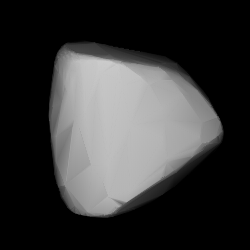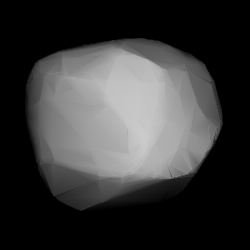Related Research Articles
2934 Aristophanes, provisional designation 4006 P-L, is a carbonaceous Veritasian asteroid from the outer regions of the asteroid belt, approximately 22 kilometers in diameter. It was discovered during the Palomar–Leiden survey in 1960, and later named after ancient Greek dramatist Aristophanes.

Hekate is a large main-belt asteroid.

Hera is a moderately large main-belt asteroid with an orbital period of 4.44 years. It was discovered by Canadian-American astronomer James Craig Watson on September 7, 1868, and named after Hera, queen and fifth in power of the Olympian gods in Greek mythology. This is a stony S-type asteroid with a silicate surface composition.

Lachesis is a large main-belt asteroid. It was discovered by French astronomer Alphonse Borrelly on April 10, 1872, and independently by German-American astronomer Christian Heinrich Friedrich Peters on April 11, 1872, then named after Lachesis, one of the Moirai, or Fates, in Greek mythology. A Lachesean occultation of a star occurred in 1999 and was confirmed visually by five observers and once photoelectrically, with the chords yielding an estimated elliptical cross-section of 184 × 144 km.

Koronis is a main-belt asteroid that was discovered by Russian astronomer Viktor Knorre on January 4, 1876, from the Berlin observatory. It was the first of his four asteroid discoveries. The meaning of the asteroid name is uncertain, but it may come from Coronis the mother of Asclepius from Greek mythology. Alternatively, it may come from Coronis, a nymph of the Hyades sisterhood. The Koronis family is named after this asteroid.

Aemilia is a large main-belt asteroid. Aemilia was discovered by the French brothers Paul Henry and Prosper Henry on January 26, 1876. The credit for this discovery was given to Paul. It is probably named after the Via Aemilia, a Roman road in Italy that runs from Piacenza to Rimini.

161 Athor is an M-type Main belt asteroid that was discovered by James Craig Watson on April 19, 1876, at the Detroit Observatory and named after Hathor, an Egyptian fertility goddess. It is the namesake of a proposed Athor asteroid family, estimated to be ~3 billion years old.

Lucretia is an asteroid belonging to the Flora family in the Main Belt. It was discovered by Austrian astronomer Johann Palisa on 31 October 1888 in Vienna, and is named after the middle name of Caroline Herschel, one of the first female astronomers. Light curves of this asteroid show a synodic rotation period of 4.349±0.001 h with an amplitude of 0.3–0.4 magnitude. The spin axis appears nearly perpendicular to the ecliptic.

Alice is a stony background asteroid from the inner region of the asteroid belt. It was discovered by Johann Palisa on 25 April 1890 at the Vienna Observatory.

California is an asteroid belonging to the Flora family in the Main Belt. It was discovered by Max Wolf on 25 September 1892 in Heidelberg, and is named for the U.S. state of California. This object is orbiting the Sun at a distance of 2.20 AU with a period of 3.26 yr and an eccentricity (ovalness) of 0.19. The orbital plane is inclined at an angle of 5.7° to the plane of the ecliptic.

Delia is a large Main belt asteroid. It was discovered by the French astronomer Auguste Charlois on 30 November 1894 in Nice. "Delia" is an epithet for the ancient Greco-Roman Moon goddess Artemis, for her birthplace at Delos. This asteroid is orbiting the Sun at a distance of 2.79 AU with an orbital eccentricity (ovalness) of 0.085 and a period of 4.64 yr. The orbital plane is tilted at an angle of 3.35° to the plane of the ecliptic.
Friederike is a minor planet orbiting in the asteroid belt. It is a member of the Hygiea family of asteroids.
630 Euphemia is a mid-sized Eunomian asteroid.
740 Cantabia is a minor planet orbiting the Sun. It was discovered on 10 February 1913 at Winchester, Massachusetts by American amateur astronomer J. H. Metcalf. Cantabia is a contraction of Cantabrigia, Latin for Cambridge, named in honor of Cambridge, Massachusetts. It is orbiting at a distance of 3.05 AU with a period of 5.33 years and an eccentricity (ovalness) of 0.11. Between 2014 and 2021, 740 Cantabia has been observed to occult three stars.

746 Marlu is a dark and large background asteroid from the outer regions of the asteroid belt, approximately 72 kilometers in diameter. It was discovered on 1 March 1913, by German astronomer Franz Kaiser at the Heidelberg Observatory in southwest Germany. The primitive P-type asteroid has a rotation period of 7.8 hours. It was named after the discoverer's daughter, Marie-Louise Kaiser.
774 Armor is a minor planet orbiting in the main belt. It was discovered on December 13, 1913, in Paris by French astronomer Charles le Morvan and was named after the Celtic region of Armorica. The asteroid is orbiting at a distance of 3.05 AU with a period of 5.32 yr and an eccentricity of 0.169. The orbital plane is inclined by an angle of 5.56° to the plane of the ecliptic.
995 Sternberga is a main-belt asteroid discovered in 1923 by Sergei Belyavsky at Simeiz Observatory. It was named after Russian astronomer Pavel Shternberg.
5120 Bitias is a Jupiter trojan from the Trojan camp, approximately 48 kilometers in diameter. It was discovered on 13 October 1988, by American astronomer Carolyn Shoemaker at the Palomar Observatory in California. The assumed C-type asteroid has a rotation period of 15.2 hours. It was named after Bitias, a companion of Aeneus in Virgil's Aeneid.
4792 Lykaon is a dark Jupiter trojan from the Trojan camp, approximately 51 kilometers in diameter. It was discovered on 10 September 1988, by American astronomer Carolyn Shoemaker at the Palomar Observatory in California. The possibly elongated Jovian asteroid belongs to the 100 largest Jupiter trojans and has a long rotation period of 40.1 hours. It was named after the Trojan prince Lycaon from Greek mythology.
1185 Nikko, provisional designation 1927 WC, is a stony asteroid from the inner regions of the asteroid belt, approximately 10 kilometers in diameter. It was discovered on 17 November 1927 by Okuro Oikawa at the Tokyo Astronomical Observatory, Japan. The asteroid was named after the Japanese city of Nikkō.
References
- ↑ "eugenesis" . Oxford English Dictionary (Online ed.). Oxford University Press.(Subscription or participating institution membership required.)
- ↑ "743 Eugenisis (1913 QV)". JPL Small-Body Database . NASA/Jet Propulsion Laboratory . Retrieved 5 May 2016.
- 1 2 Stephens, Robert D. (June 2005), "Rotational periods of 743 Eugenisis, 995 Sternberga, 1185 Nikko 2892 Filipenko, 3144 Brosche, and 3220 Murayama", The Minor Planet Bulletin, 32 (2): 27–28, Bibcode:2005MPBu...32...27S.
- ↑ Bus, Schelte J.; Binzel, Richard P. (July 2002), "Phase II of the Small Main-Belt Asteroid Spectroscopic Survey. A Feature-Based Taxonomy", Icarus, 158 (1): 146–177, Bibcode:2002Icar..158..146B, doi:10.1006/icar.2002.6856.